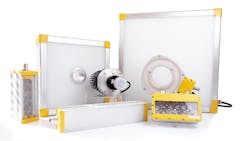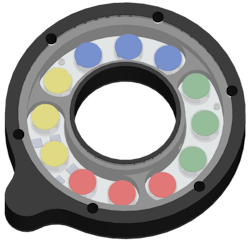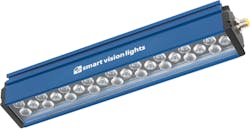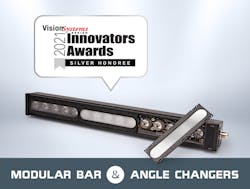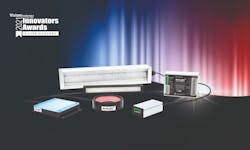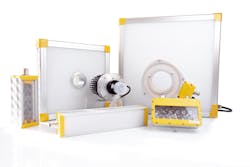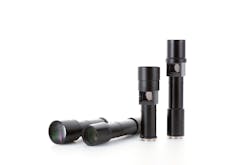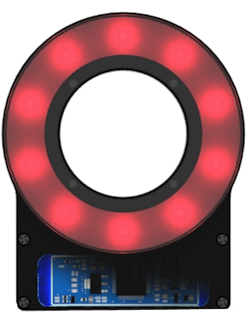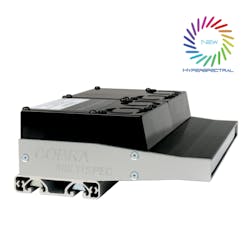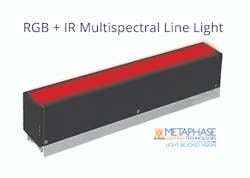Designing for camera advances key for lighting and illumination suppliers
If you can’t see it, you can’t inspect it. If you can’t see it, you can’t read it. Lighting and illumination challenges are never ending, and since it’s not feasible, more often than not, to perform vision and imaging functions in the sun, systems integrators are always trying to find ways to properly illuminate objects for imaging. Where it all begins, of course, is with the light chosen for the application. The variety of lighting and illumination choices available to systems integrators and end users addresses myriad challenges that exist for proper illumination. Borja Pérez de Anuzita, Product Manager, DCM Sistemes (Valencia, Spain; www.dcmsistemes.com), says, “We must keep in mind that a camera can only capture what it can see, so to process an image, it is essential to have the scene properly illuminated. Choosing the right lighting for an application has to be the starting point for any machine vision system. Good illumination is essential to ensure that the application will be developed successfully.”
Challenges
There are numerous challenges that impact systems integrators, end users, and lighting suppliers when designing vision and imaging systems. As important as it is to maintain continual camera innovation, improvements in technology as well as new imaging technologies create needs for new types of lighting. Timing is also key. Determining the illumination requirements for an application as early as possible will help reduce costs for the end user. And, for suppliers, customers often ask for custom or semi-custom lighting solutions.
Torben Deike, Product Manager, Companion Products at Basler AG (Ahrensburg, Germany; www.baslerweb.com) stresses that three challenges stand out when selecting lighting for vision systems:
- Time of selection: Late consideration of lighting leads to the need for customized or do-it-yourself lighting solutions, resulting in higher costs and longer time-to-market.
- Product standards/interoperability: It takes time and very specific engineering knowledge to integrate non-standard lighting into a vision system.
- Material wear and specifications: Aging of illuminants or rapidly changing specifications have a detrimental effect on consistently good image quality.
“To master these challenges in the best possible way, Basler recommends that customers consider suitable standard lighting as early as possible when setting up their vision system and choosing a suitable camera and lens,” says Torben Deike. “Smooth integration and scheduled implementation are additionally supported by using harmonized components from a single source. Furthermore, only industrial-grade lighting should be used to ensure consistent image quality and low maintenance effort.”
“Systems integrators and vision system designers are faced with the challenge of adapting to the current market needs for more custom and semi-custom lighting, particularly in volume and/or OEM applications,” says John Thrailkill, CEO and Co-Founder of Advanced illumination (Rochester, VT, USA; www.advancedillumination.com). “Many end-user customers tend to have very specific requirements, which forces systems integrators and machine builders, as well as their vendor suppliers, to be very quick to respond with a custom or semi-custom solution. Many times, the first vendor to provide a solution wins the business.”
Matt Pinter, Founder and CTO of Smart Vision Lights (Norton Shores, MI, USA; www.smartvisionlights.com), also cites keeping up with technology as a challenge, including lights to complement the new technologies that the camera manufacturers are producing. “Cameras that have new technologies in imagers (polarization, SWIR/multispectral) and advancements with new algorithms including photometric, sensors for phase deflectometry, deep learning—lights will need to complement the camera industry with lights developed for these new technologies,” he says.
Matching illumination to the expanding number of image sensors available is also one of the challenges Jason Baechler, President, MORITEX North America, Inc. (San Jose, CA, USA; www.moritex.com), identifies. “Getting enough light for applications continues to be a challenge, but today with the variety of options for LED chips in the market, other requirements are posing limits or challenges,” he says.
“The balance of ‘good enough’ lighting at competitive prices and package sizes for easy integration also are common challenges,” Baechler continues. “What we have seen more of in the past one to two years though are challenges matching illumination solutions to the expanding image sensors in the markets. This may be as simple as designing a light that is bright enough for an application but not too bright to reduce depth of field or wash-out sensors. Or, it can be as complex as finding the best non-visible wavelengths for a sensor’s sensitivity while also creating contrast for objects.”
Simon Stanley, Director of Technology at ProPhotonix (Salem, NH, USA; www.prophotonix.com), adds, “As new technologies such as multispectral and hyperspectral imaging advance, they bring with them greater opportunities for inspection, enabling both new applications and, in some cases, multiple inspections to be carried out simultaneously. For lighting in particular, these applications are inherently more demanding, requiring expert wavelength configuration to meet the application needs as well as spectral balancing and exceptional control to maximize the potential of these new technologies.”
The number of lighting options available to systems integrators and end users also poses a challenge, according to Caroline Winn, Vice President of Sales for TPL Vision (Perth, Scotland, UK; www.machinevisionbar.com). “There is a bewildering array of illumination products—tens of thousands—available to system designers and integrators,” she says. “Knowledge and expertise are needed to choose the right illumination; it is difficult and time consuming to identify, evaluate, then select the most suitable illumination for the application. But even after completing the design, it is possible that illumination product changes can still be required due to the different ambient lighting conditions between design location and final installation, which can cause project delays. Fully featured yet flexible lighting solutions can help solve these challenges, enabling users to quickly adapt the illumination to suit the installation environment, without requiring deinstallations.”
“Metaphase has hundreds of thousands of different configuration LED illuminators, not because we want to have a large number of lights, but that is what’s needed to support the machine vision market,” adds Mark Kolvites, Senior Technical Sales Manager, Metaphase Technologies (Bristol, PA, USA; www.metaphase-tech.com). “Products being inspected come in various shapes, sizes, and colors and therefore require different lengths, shapes, and wavelength illumination to maximize contrast. Often there is limited space for the vision system equipment, therefore components such as the illumination need to be compact yet intense while having the necessary mass to keep the LEDs at an acceptable operating temperature. This leads to the necessity of having many sizes, shapes, types, and LED wavelengths of illuminators.”
According to Yuji Sugahara, Director, Product Development Department, VS Technology (Tokyo, Japan; vst.co.jp) there are two challenges systems integrators and vision system designers face: simulating the balance between heat dissipation and brightness in high-brightness applications in limited spaces and finding optimum lighting to match artificial intelligence applications.
John Merva, Vice President, North America, Gardasoft (Cambridge, UK; www.gardasoft.com) says challenges for lighting fall into two areas:
Providing proper lighting geometry to ensure desired features are highlighted while unimportant features are suppressed. This is accomplished by selecting the proper light shape and illumination wavelength.
Providing consistent, accurate illumination from one image to the next. This is accomplished by driving the LEDs with exactly the same current and measuring the pulse time precisely.
Lindsey Dragan, Application Engineer, CCS America (Kyoto, Japan (headquarters); www.ccs-grp.com) states, “In our experience, the biggest challenges arise from the mismatch between easily visually identifiable defects and machine vision capabilities. In other words, we can see the defects with our eyes, but that does not mean the camera can reliably detect them—often in the realm of color matching and anything made by nature.”
Solutions
Although lighting and illumination are always challenging for machine vision and imaging applications, systems integrators and end users benefit from a variety of products from which to choose to match the right light with the right camera and to the right application.
Spectrum Illumination (Montague, MI; USA; www.spectrumillumination.com) specializes in custom lighting solutions. “These customizations vary from specific LED wavelengths or CRI needs to dual-channel options,” says David Hardy, Design Engineer/VP, Spectrum Illumination. “A popular combination for our customers in the dual-channel lights has been white and infrared. These dual-channel linear lights help address several issues. For example, they have been used in the sorting of recycled materials, plant identification, etc. We offer the dual-channel option in our Monster Series linear lights up to 80.5 in. or 2 m in length, making large conveyor sorting possible. Custom lengths are available up to 161 in. or 4 m in length. We also offer dual-channel ring lights that can aid in part location/feature verification. One popular combination in these ring lights has been using white for part location, then UV to verify things such as glue presence.”
Spectrum Illumination has also engineered segmented lighting in its lights. Segmented lighting or Photometric Stereo has revealed features that were difficult to detect using a non-segmented or single-source light. “We now offer this four-segment option in several of our models. In our Monster Domes, we can do it in our DL85, MDL12.25, and MDL29.25. In our Monster Ring Lights, we can do it on our MRL5.5 (Figure 1), MRL13.5, and MRL30.5 ring lights. The RL/DF series lights available in 4 or 8 in. can also be ordered to control the four segments individually,” Hardy adds.
Smart Vision Lights’ newest lights are tailored to solve the latest technological issues facing cameras. For example, the LTF (linear tunable field of view) (Figure 2) lights are electronically controlled field-of-view (FoV) lights, allowing systems integrators and end users to adjust the light projection angle without any moving parts and configure it to fit specific application needs. Available in every standard wavelength as well as IR, SWIR, and UV, the LTF is a three-channel light where the LED for each channel has either a wide, medium, or narrow lens. Users can control the lighting angle and working distance by switching or mixing the channels.
TPL Vision’s LED illumination products are designed to illuminate the user’s FoV with the best balance between brightness and homogeneity.
TPL Vision’s Modular High Intensity Bar with Angle Changers (Figure 3) is for use in almost all illumination applications. Modular Bars with Angle Changers shape the light output angles, providing narrow, medium, wide, and line light output angles, in addition to the Modular Bar’s Ultra-Narrow output angle. The Angle Changers’ patent pending design securely mounts on the top surface of the Modular Bar, acting as adjustable tertiary optics without compromising the bar’s IP rating.
Advanced illumination LED lighting is designed to address a multitude of lighting challenges, particularly because the lighting is designed for configurability. A significant portion of the company’s standard lighting includes pre-engineered scalability, multiple wavelength options (some feature up to 16 available wavelengths), lensing options, and LED pitch. Its UltraSeal Washdown Lights (Figure 4) are IP69K certified and engineered with a sealed, flush surface, making them virtually crevice-free. The UltraSeal lights feature pre-engineered scalability. This allows for cost-effective build-to-order and semi-custom designs, providing greater customization for end users. The UltraSeal family currently features Backlights and Bar Lights, with Spot Lights releasing in 2021 followed by additional light types in the future.
In cooperation with CCS, Basler has developed a portfolio of various intelligent lighting components. The Basler SLP lighting solution (Figure 5) powered by CCS is designed to match the Basler ace U and ace L camera models equipped with the Basler SLP feature. The Basler SLP feature makes it very easy for the user to control both the camera and the lighting by using only one software interface, the Basler pylon Camera Software Suite. Direct communication between camera and light source reduces the complexity of a vision system significantly. Synchronization between camera and lighting is done automatically, which saves time during initial operation but also in the case of modifications during ongoing operation. With the Basler SLP feature, even strobing and overdrive functions are accessible and can be used even by less experienced users.
CCS offers solutions and products used by clients in numerous industries for applications ranging from food and beverage, pharmaceuticals, automotive, logistics, semiconductor, and general manufacturing. For example, the EFFILUX series lights (Figure 6), designed and manufactured by CCS Group member EFFILUX (Paris, France; www.effilux.com) include a comprehensive range of plug-and-play lighting specifically designed to fit the different needs of machine vision applications, including large illumination areas, robotics, logistics, and automotive. The lights offer a built-in controller and M12 connector for plug-and-play connection. With adjustable lenses, diffusers, and optical accessories, customers can design the optimal lighting solution.
At VS Technology, Sugahara says integrating lens and lighting is an important advancement for machine vision and imaging, citing the company’s VS-LTC WD130mm (Figure 7) series that uses area type LED lighting for built-in coaxial lighting to produce high uniformity.
iBlueDrive (Figure 8) is a technology developed by DCM Sistemes to ease the use of advanced LED lighting systems for machine vision. iBlueDrive devices allow users to work in strobe mode almost as easily as in continuous mode. They consist of a lighting device with an intelligent built-in microstrobe controller. Only a three-terminal cable is needed to power and control the lighting. iBlueDrive devices can be triggered up to 5.0 pps. iBlueDrive lights have only a single multifunctional control terminal, whether they are monochrome, RGB, or multisector devices. Connection can be done directly to the camera or to the trigger signal such as photocell, inductive sensor, or automaton output. It is possible to use either PNP or NPN trigger signals to control the light. The device will automatically detect which type of signal you are using so no presetting is needed.
ProPhotonix provides a range of lighting solutions for vision applications, according to Stanley, from configurable out-of-the box LED lights to custom designed and manufactured solutions to address specific application needs. For example, the hyperspectral version of the company’s COBRA MultiSpec (Figure 9) has a spectral range from 400 to 1000 nm. Expert wavelength configuration and balancing ensures a spectrum optimized for hyperspectral line scan cameras operating in the visible to near-IR spectrum. Spatial and spectral uniformity and control make this new LED line light suitable for hyperspectral applications.
Some applications can take advantage of multispectral cameras and multispectral LED illumination, according to Kolvites. “Metaphase offers a wide variety of multispectral illumination such as RGB and NIR, where the RGB and IR LEDs are in the same light, and the different wavelengths can be controlled independently,” he says. “These multispectral lights, when used in conjunction with a prism-based multispectral camera where the incoming light is split into different optical paths, each having its own spectral sensitivity, can be used to inspect different features of the object at the one single camera station.”
One example of illumination of this type from Metaphase is its family of multispectral LED lights, the RGB + IR LED Line Lights (Figure 10). The lights feature individually controllable RGB + IR LEDs to maximize contrast. They are suitable for print inspection, banknote, package and label inspection, food inspection, and more. Traditionally multispectral line scan inspection applications, such as agriculture (fruit, meat, etc.) inspection, required multiple inspection stations, each with its own camera and unique single wavelength (color) LED light. Multispectral cameras along with these Metaphase line lights configured with individually controllable RGB + IR LEDs can perform all these inspections at a single station.
Keeping pace with camera technology
For both end users and manufacturers, keeping up with the advances in camera technologies will continue to be a challenge. In addition, ensuring that you are using the correct lighting for the application is key. There are some lights that will not work with certain methods of imaging. Controlling the light is also paramount, as is ensuring that the lighting and machine vision programming complement each other.
Speed to market, according to Pinter, will also be important. “The winners in the lighting industry for machine vision will be companies developing lights for cameras with new technologies in very short development times,” he says. “New lights will need to go from ideas to working units in two to four weeks. This can be accomplished using the latest technologies like 3D printing, in-house SMT circuit board development, and machining parts that can’t be 3D printed.”
Winn adds, “Emerging new technologies such as artificial intelligence (AI) still rely on the ability of the imaging system to capture stable images with good contrast. The correct illumination is as critical in these applications as it has always been for non-AI powered machine vision camera applications. White light is not always the best choice of color for the illumination, and the built-in illumination embedded in cameras is by its very design often not in the optimum position for creating the best imaging results. For these reasons and more, external LED illumination will continue in helping to achieve robust inspections with stable, well contrasted images for years to come.”
Equally important is supporting end users once they make their selection. Thrailkill says that finding the right lighting solution is one of the most difficult aspects of specifying machine vision systems, but beyond the light itself, support for understanding the proper lighting technique and method of deployment is critical. “We offer a Sample Evaluation Program as an added service to customers, where they may send in a sample of the objects they need to inspect,” he says. Our team then works with the customer to find the most robust lighting solution, including light type, angle of incidence, wavelength, etc. We also support customers with our Loaner Program, where they may test those lights in their actual application to determine success. And, should a customer require a more dedicated solution, our team of experts is here to ensure they end up with the most robust, successful lighting solution.”
Physical characteristics of the lights also play a role. Anuzita says, “The challenge faced by integrators is that their applications require more powerful equipment to be able to cover larger areas and faster applications, more compact systems to be used in impossible spaces, lighter systems to be able to be installed on robots, illuminators with greater protection to be used in aggressive environments, and of course, systems that allow us to have total control over lighting.”
No other component in an imaging system can overcome faulty lighting, according to Torben Deike. “Lighting components and their selection and integration play a crucial role in any vision system,” he says. “Lighting, together with other vision components such as the camera and lens, provides and manages the light to achieve the best possible results from your vision system. Faulty lighting cannot be compensated by any other component. Therefore, high demands apply to the quality, reliability, and long-term availability with a good price/performance ratio. Users should think about the right lighting early on to save time and money.”
Dragan stresses the importance of the correct lighting and the correct programming for solving any application. She states that images that capture defects in products depend on proper light choice and utilization, and the correct image cannot be reliably captured if the right light and setup is not chosen. “Similarly, imperfect programming will hinder the ability to implement any actual solution even if every image is pristine,” she says. “Both the lighting and coding need to work in unison to consistently solve applications. Proper equipment choice creates the ideal image to solve the application and saves the user excessive hassle of swapping out filters or other parts on a regular basis and time trying to compensate a poor lighting setup with camera software filters resulting in reliable solutions. But even with an extremely well-written program, if the image does not show the defect, the program has little value. However, even with the best image, if the program cannot interpret said image, the results will not be reliable. You need both to work together for the best results.”
LEDs have become prevalent in all walks of life in recent years, and their use in vision and imaging systems is not a surprise. Baechler says, “LED efficiencies have always been at the core of advancements for vision systems, and this is even more important for non-visible wavelengths, especially in light-starved IR-SWIR applications.”
Merva adds, “It took over a decade for the market to realize that LEDs are the best, most efficient, and most stable illumination sources for machine vision systems. The same realization needs to occur for lighting control. Voltage-driven lights are susceptible to intensity variations, which induce differences in inspection results because of the lack of stability of commercial voltage power supplies. Optimum consistency of inspection results will occur when all users employ current drive lighting controllers.”
Kolvites states, “Although camera sensors continue to improve in terms of sensitivity, resolution, and speed, the demand for higher performance illumination continues to grow as machine vision systems are used in increasingly challenging applications. Primarily due to the increase of LEDs in the consumer markets, the LED options for increased intensity, primary and secondary lensing, wavelength choices, and efficiency have also increased, resulting in machine vison LED illuminator manufacturers being able to provide more optimized solutions for each unique application.”
Camera technology is moving fast, and lighting and illumination providers work to keep pace with these developments. Stanley concludes, “The market for machine vision lighting and systems continues to develop and it is exciting to see new applications opening up. As a lighting manufacturer, we must remain agile to best support these developments.”
Companies Mentioned
Advanced illumination
Rochester, VT, USA
www.advancedillumination.com
Basler AG
Ahrensburg, Germany
www.baslerweb.com
CCS Lighting
Kyoto, Japan
www.ccs-grp.com
DCM Sistemes
Valencia, Spain
www.dcmsistemes.com
Gardasoft
Cambridge, UK
www.gardasoft.com
Smart Vision Lights
Norton Shores, MI, USA
www.smartvisionlights.com
Metaphase Technologies
Bristol, PA, USA
www.metaphase-tech.com
MORITEX North America, Inc.
San Jose, CA, USA
www.moritex.com
ProPhotonix
Salem, NH, USA
www.prophotonix.com
Spectrum Illumination
Montague, MI, USA
www.spectrumillumination.com
TPL Vision
Perth, Scotland, UK
www.tpl-vision.com
VS Technology
Tokyo, Japan
vst.co.jp
For more information about lighting and illumination companies and products, visit Vision Systems Design's Buyers Guide at www.vision-systems.com/directory.
About the Author
Chris Mc Loone
Editor in Chief
Former Editor in Chief Chris Mc Loone joined the Vision Systems Design team as editor in chief in 2021. Chris has been in B2B media for over 25 years. During his tenure at VSD, he covered machine vision and imaging from numerous angles, including application stories, technology trends, industry news, market updates, and new products.
